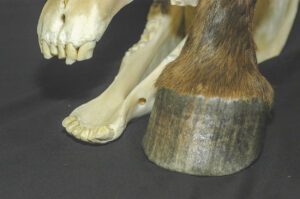Chronic Laminitis: Understanding Lameness and Low-Dose Bute
To treat any lameness issue a veterinarians must first identify the origins of pain and etiologies responsible–something that can be particularly challenging in a horse with laminitis. David Hood, DVM, PhD, of the Hoof Diagnostic and Rehabilitation Clinic (HDRC) in Bryan, Texas, shared some effective methods to pinpoint laminitic pain and explored using the non-steroidal anti-inflammatory (NSAID) phenylbutazone (Bute) to control it at the 6th International Equine Conference on Laminitis and Diseases of the Foot, held Oct. 28-31 in West Palm Beach, Fla.
Veterinarians often use differential nerve blocks to pinpoint pain’s region of origin (e.g., solar, heel, fetlock, metacarpal, etc.). In a series of experiments using nerve blocks on chronically laminitic horses coupled with force plate evaluation of lameness severity, Hood noted the following results:
- Not all lameness is a result of pain avoidance (Some "appear to be related to chronic elevation of the heels and/or contracture of the flexor tendons and suspensory apparatus," Hood explained.);
- Most lameness originates in the solar and heel regions, rather than the laminar interface.
- Nondigital lameness (such as due to degenerative joint disease higher up in the limb) frequently is superimposed on digital lameness; and
- There is a high incidence of hind limb lameness in horses with chronic laminitis, attributed to "repeated overloading of the rear limbs in attempts to rise without fully loading the forefeet," said Hood.
Hood also described an experimental study on Bute’s pain-relieving effects in which he administered low-dose oral Bute to 20 laminitic horses 30 minutes before morning feeding, followed by performing a force plate-based stance analysis in the afternoon.
Hood noted rapid response (lameness improvement) in 30-50% of the horses within the first 24 hours. Their pain levels plateaued (stopped improving), however, after four to 10 days on this regimen. When treatment was discontinued after 10 days the horses all returned to their original levels of lameness within three to eight days
Create a free account with TheHorse.com to view this content.
TheHorse.com is home to thousands of free articles about horse health care. In order to access some of our exclusive free content, you must be signed into TheHorse.com.
Start your free account today!
Already have an account?
and continue reading.

Related Articles
Stay on top of the most recent Horse Health news with

















